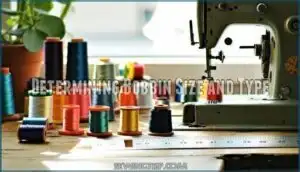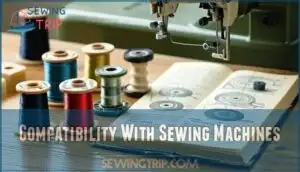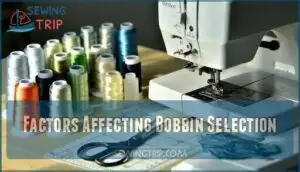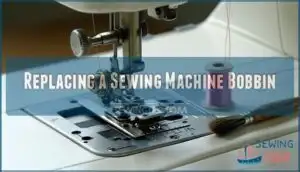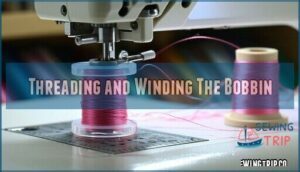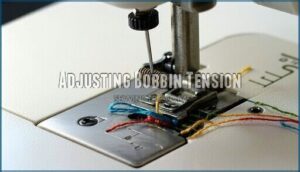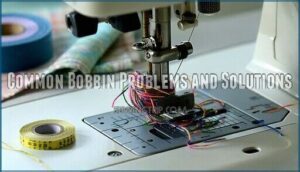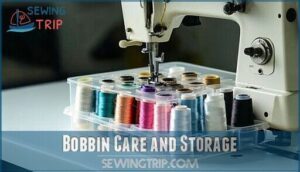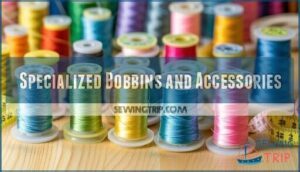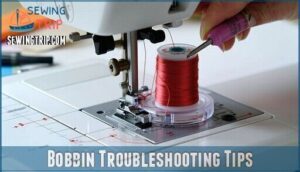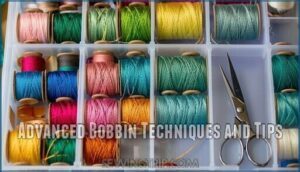This site is supported by our readers. We may earn a commission, at no cost to you, if you purchase through links.
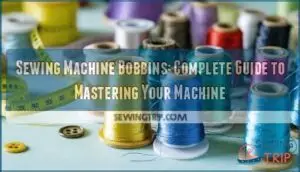
You’ll find different types like Class 15 bobbins for most home machines, or specialized ones like Singer 163131 for specific models.
When your bobbin isn’t working right, it’s usually a threading or tension issue. Think of it as the engine under your car’s hood – you don’t see it, but it makes everything run smoothly.
Loading the bobbin correctly and keeping it clean prevents most sewing headaches. Once you master these little thread holders, your stitching becomes effortless and professional-looking.
Table Of Contents
- Key Takeaways
- Sewing Machine Bobbin Basics
- Bobbin Functions and Importance
- Choosing The Right Bobbin
- Bobbin Installation and Maintenance
- Common Bobbin Problems and Solutions
- Bobbin Care and Storage
- Specialized Bobbins and Accessories
- Bobbin Troubleshooting Tips
- Advanced Bobbin Techniques and Tips
- Frequently Asked Questions (FAQs)
- Conclusion
Key Takeaways
- You’ll need to match the right bobbins type to your specific sewing machine – Class 15, L, M, or 66 styles aren’t interchangeable, and using the wrong one causes tension problems and poor stitches.
- You can prevent most bobbins issues by winding thread evenly at moderate speed, threading correctly through tension discs, and keeping your bobbin case clean of lint and debris.
- You should adjust bobbins tension when stitches look messy by turning the small screw on your bobbin case in 1/8-inch increments – clockwise tightens loose thread, counterclockwise loosens tight thread.
- You can extend your bobbins’ life by storing them in organized cases to prevent tangling, inspecting them monthly for cracks or damage, and using quality thread that won’t fray or break during sewing machine use.
Sewing Machine Bobbin Basics
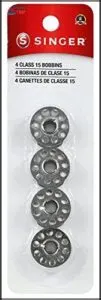
Think of bobbins as your sewing machine’s secret partner—they’re small cylindrical spools that hold the bottom thread while your needle carries the top thread.
Your bobbin is the unsung hero turning two threads into perfect stitches—small but mighty!
Together, they create every stitch you make.
These little workhorses come in different sizes and materials like plastic or metal, and here’s the catch: they’re not one-size-fits-all.
Each sewing machine needs its specific bobbin type to function properly.
Using the wrong bobbin is like trying to fit a square peg in a round hole—it just won’t work right.
Best For: Beginners to intermediate home sewers using specific SINGER or Brother sewing machines that require durable Class 15 metal bobbins.
- Durable metal construction ensures long-term use.
- Compatible with popular SINGER and Brother sewing machine models.
- Prevents thread tangling and breakage when fully wound.
- Not suitable for industrial or heavy-duty machines.
- Requires careful size checking to avoid compatibility issues.
- Improper thread winding can lead to sewing problems.
Bobbin Functions and Importance
Your bobbin holds the bottom thread that works with your needle’s top thread to create every stitch your machine makes.
Think of your bobbin as the unsung hero—without it, your sewing machine simply can’t create a single stitch.
Without this small but essential part, your sewing machine can’t form the interlocking loops that hold your fabric pieces together, which is why the bobbin is crucial for the interlocking loops.
How Bobbins Work With Thread
Your bobbin plays a key role in the thread delivery system.
Here’s how it works:
- The bobbin thread feeds upward through the thread path below your fabric.
- It meets the needle’s thread to create the bottom stitch in the fabric.
- Proper thread tension between top and bobbin threads is essential for smooth stitch mechanics.
- Balanced tension balance guarantees consistent stitch formation and prevents uneven stitches or messy thread nests.
Role of Bobbins in Stitch Formation
In the context of stitching, the bobbins thread plays a starring role in creating those reliable, interlocking stitches.
It feeds as the bottom thread, partnering perfectly with the upper thread.
Proper bobbins tension makes for smooth fabric feed, boosting seam quality.
If the tension’s off, you might face bobbins problems like tangles or inconsistent stitch formation, so keep thread tension balanced for flawless results every time!
Choosing The Right Bobbin
Picking the right bobbin makes all the difference in your sewing machine’s performance.
You’ll need to match the size, type, and material to your machine, so everything runs smoothly.
Determining Bobbin Size and Type
Finding the right bobbin might feel like matching socks after laundry—simple but tricky if you don’t know where to start. It all begins with knowing your machine’s needs. Bobbin dimensions, like diameter and height, must match. Common bobbin types include Class 15 (27.3 mm diameter) and L Style (20.3 mm diameter, 8.9 mm height).
Always check your machine manual. It’s your sewing bible for bobbin compatibility. A bobbin size chart helps if labels confuse you.
Material also matters—plastic bobbins are lighter, great for delicate fabrics. Metal ones offer durability, ideal for heavy-duty projects.
Here’s what to keep in mind:
- Brand specifics: Machines often prefer certain bobbins.
- Thread capacity: Bigger bobbins hold more thread.
- Measuring bobbins: Use a ruler for accuracy.
Compatibility With Sewing Machines
Your sewing machine isn’t a “one-size-fits-all” kind of tool regarding bobbins.
Sewing machine compatibility depends on the machine’s model and design.
Class 15, L-style, and M-style bobbins all vary in size, shape, and material.
Picking the wrong type can mess with tension adjustments, causing jams or uneven stitches.
Always rely on your manual to verify the right bobbin compatibility, enhancing your machine’s performance and preserving its efficiency.
Factors Affecting Bobbin Selection
When choosing sewing machine bobbins, think beyond size. The material matters—metal bobbins handle bulky fabrics and fast speeds, while plastic bobbins suit lighter sewing projects.
Thread type is key too; thicker threads need bobbins with space to hold more. And don’t forget your project’s demands—special bobbins enhance embroidery or quilting work.
Here’s what to keep in mind:
- Machine Compatibility: Always match bobbins to your machine model.
- Material Durability: Metal lasts longer; plastic is lightweight.
- Thread Type: Thicker threads equal larger-capacity options.
- Budget Considerations: It’s tempting, but don’t skimp!
Smart bobbin selection equals perfect stitches!
Bobbin Installation and Maintenance
Installing and maintaining your bobbin properly keeps your sewing projects running smoothly. With a little care, you’ll avoid thread tangles, skipped stitches, and unnecessary frustration.
Replacing a Sewing Machine Bobbin
Swapping out sewing machine bobbins doesn’t have to be a chore. With a few simple steps, you’ll master the process in no time.
First, remove the old bobbin by releasing its latch in the bobbin case. While the case is open, grab a small brush to remove lint or stray threads—it’s like giving your machine a quick spa day. Now, insert the new bobbin, verifying the thread unwinds counterclockwise (double-check your manual to be sure).
Here’s a handy checklist:
- Release the bobbin case latch and remove the old bobbin.
- Clean the bobbin case of lint and debris.
- Insert the new bobbin with thread unwinding counterclockwise.
- Thread through the tension slot carefully.
- Test the thread’s alignment and resistance.
Perform post-replacement testing to guarantee smooth sewing!
Threading and Winding The Bobbin
With your new bobbin in place, it’s time to get that thread wound properly.
Start manual winding or use automatic winders at moderate winding speed—too fast creates uneven layers.
Guide thread through your machine’s thread tension discs for consistent bobbin fill.
Keep steady pressure while winding to prevent loose spots.
Stop when the bobbin feels full but not overstuffed.
Remember, good bobbin winding and bobbin threading make all the difference in your stitching success.
Adjusting Bobbin Tension
Why does your perfect stitch suddenly look like a tangled mess? Bobbin tension issues often create stitch quality problems that’ll drive you crazy.
Here’s your tension troubleshooting guide for sewing machine bobbins:
- Locate the tiny screw on your bobbin case – it’s your tension adjustment tool
- Turn clockwise in 1/8 increments to tighten loose bobbin thread
- Test on scrap fabric after each micro-adjustment
- Consider fabric weight impact – heavier materials need different tension
- Keep a backup bobbin case unadjusted as your failsafe baseline
These expert tension tips prevent future bobbin problems.
Common Bobbin Problems and Solutions
Even the best sewers face bobbin troubles, from loose threads to bobbins that won’t catch or spin properly.
You’ll find quick fixes for these common issues here, so you can get back to creating without the frustration.
Loose Bobbin Thread
That pesky loose bobbin thread creating messy stitches underneath your fabric? You’re not alone.
This frustrating bobbin problem usually stems from incorrect needle size or poor thread quality affecting your bobbin tension.
| Common Cause | Quick Fix |
|---|---|
| Wrong needle size | Match needle to fabric weight |
| Poor thread quality | Use high-quality thread |
| Dirty bobbin case | Clean lint and debris |
| Incorrect tension adjustment | Test stitch and adjust gradually |
| Improper threading | Rethread following manual steps |
Small tension adjustments solve big bobbin troubleshooting headaches through proper machine cleaning!
Bobbin Not Catching or Spinning
When your bobbin refuses to catch or spin, you’re dealing with one of the most common bobbin problems that can halt your project mid-stitch. Machine timing issues or needle alignment problems often cause this frustrating situation.
Here’s your bobbin troubleshooting checklist:
- Clean lint buildup from the bobbin case and surrounding areas
- Check that your bobbin case sits properly without wobbling
- Verify thread quality isn’t causing snags or tangles
- Confirm the bobbin thread feeds smoothly without resistance
- Test bobbin tension by pulling the thread gently
Sometimes the simplest fix works best, and following these steps can help resolve issues with your bobbin, ensuring a smooth and trouble-free sewing experience.
Bobbin Thread Breaking
When your bobbin won’t spin, the next headache you’ll face is thread breaking mid-stitch. This frustrating bobbin problem stops your project cold and signals deeper tension issues.
Here’s how to fix bobbin thread breaking:
- Adjust bobbin tension by loosening the small screw on your bobbin case
- Check thread quality – cheap thread frays and snaps easily
- Verify needle compatibility with your thread weight and fabric
- Perform regular machine maintenance to remove lint buildup
Bobbin Care and Storage
Taking care of your bobbins properly will extend their life and prevent frustrating sewing problems like thread tangles and tension issues.
You’ll save time and money by learning simple cleaning techniques and smart storage methods that keep your bobbins organized and ready for your next project, using simple techniques and smart storage methods.
Cleaning and Inspecting The Bobbin
Clean bobbins are happy bobbins, and yours will thank you for regular attention. Start with lint removal using a small brush to clear debris from grooves and threading holes. Your damage detection routine should catch cracks, burrs, or warping before they cause bobbin problems.
| Cleaning Step | What to Check | Red Flags |
|---|---|---|
| Case Cleaning | Thread debris buildup | Sticky residue, oil spots |
| Tension Check | Spring mechanism | Loose or bent parts |
| Visual Inspection | Bobbin surface | Cracks, chips, rough edges |
Schedule sewing machine maintenance monthly for ideal bobbin case performance and smooth stitching.
Storing Bobbins and Preventing Tangling
Smart bobbin storage prevents thread chaos in your sewing space.
Here’s how to keep things tidy:
- Use bobbin organizer cases with individual slots for each spool
- Wrap thread tails around the bobbin or secure with bobbin toppers
- Label colors clearly on portable bobbin cases for quick identification
- Store vertically in stackable holders to maximize space
Proper thread storage with tangling prevention methods saves hours of frustration later.
Using Bobbin Boxes and Organizers
Once you’ve mastered storing bobbins properly, you’ll want the right organization methods to keep everything accessible. A well-organized sewing room starts with choosing the perfect bobbin organizer for your space saving needs.
Your bobbin storage system can make or break your sewing flow. Here’s what works best:
- Clear plastic cases let you see bobbin thread colors instantly
- Magnetic holders prevent bobbins from rolling off surfaces
- Stackable compartments maximize vertical thread storage space
- Portable organizers offer excellent portability options for classes
- Labeled containers speed up project setup and material impact reduction
Quality bobbin storage extends your bobbin storage life considerably. Many sewers purchase dedicated storage solutions to keep their bobbins organized. Choose organizers that protect threads from dust and tangling while fitting your workflow perfectly.
Specialized Bobbins and Accessories
You’ll find that certain sewing machines require specific bobbins designed for their unique mechanisms, and these specialized options can make all the difference in your stitching quality.
Whether you’re working with a Juki 270010, Viking 4125615-45, or Singer 163131 bobbin, using the right match for your machine prevents tension problems and keeps your projects running smoothly.
Juki 270010 Bobbin
Industrial powerhouse meets precision engineering in the Juki 270010 bobbin. This steel-constructed workhorse delivers exceptional Juki compatibility across DDL single needle machines, offering superior thread capacity with its 21.2mm diameter design.
You can find bobbin product sales online.
| Feature | Specification |
|---|---|
| Material Composition | Premium steel construction |
| Bobbin Sizes: 21.2mm x 9.2mm | |
| Optimal Usage | DDL machines, heavy-duty projects |
Proper tension settings require correct bobbin case installation. Wind evenly for balanced bobbin thread distribution—your sewing machine bobbins deserve this attention to detail.
Viking Specific 4125615-45 Bobbin
Looking for Viking compatibility that won’t leave you guessing? The 4125615-45 bobbin delivers reliable performance for your Husqvarna Viking machine.
This nickel-sized bobbin fits groups 5, 6, and 7 machines perfectly, ensuring smooth thread capacity and ideal tension settings.
- Nickel-sized design fits newer Viking machine models seamlessly
- Durable material composition prevents warping during extended use
- Consistent bobbin thread delivery reduces skipped stitches
- Proper bobbin case fit eliminates troublesome threading issues
Singer 163131 Bobbin
The Singer 163131 bobbin fits perfectly in your Touch & Sew machines, including models 600E through 649E series.
This nickel-sized bobbin offers excellent thread capacity for extended sewing sessions.
Its material composition guarantees smooth bobbin thread flow through your bobbin case.
You can find bobbin-related products online.
Follow these steps for superior performance:
- Check Singer sewing machine compatibility before purchase
- Wind thread evenly using proper winding techniques
- Inspect bobbin sizes match your machine specifications
- Clean lint from sewing machine bobbin area regularly
- Verify 163131 dimensions align with your model requirements to ensure proper functioning.
Bobbin Troubleshooting Tips
When your bobbin starts acting up with loose threads or skipped stitches, you don’t need to panic or call a repair shop right away.
Most bobbin problems stem from simple threading mistakes or tension issues that you can fix yourself in just a few minutes.
Checking Threading and Tension
Chaos in your stitches usually signals bobbin threading problems or poor Tension Balance. Start by examining your Thread Path through the Bobbin Case – one wrong turn creates disaster.
| Issue | Root Cause | Fix |
|---|---|---|
| Bobbin thread loose | Weak tension setting | Adjust bobbin case screw clockwise |
| Thread bunching underneath | Incorrect bobbin threading technique | Rethread following your manual exactly |
| Uneven stitches | Poor sewing machine tension | Balance top and bottom tensions |
Always grab Test Fabric to verify Stitch Quality before tackling your real project. This simple step prevents bobbin knot prevention headaches later.
Preventing Future Problems
Prevention beats repair every time in the case of bobbin problems. Smart maintenance keeps your machine humming smoothly and saves you from mid-project meltdowns.
Here’s your bobbin maintenance checklist:
- Regular Inspection – Check your bobbins monthly for cracks, warping, or rough edges that snag bobbin thread
- Correct Bobbins – Stick with your machine’s recommended type and avoid mixing plastic with metal versions
- Proper Storage – Keep bobbins in organized cases to prevent tangling and dust accumulation
- Gentle Handling – Wind slowly and avoid overfilling to prevent tension issues and bobbin knot prevention
These bobbin maintenance tips transform sewing machine troubleshooting from reactive headaches into proactive peace of mind.
Advanced Bobbin Techniques and Tips
Once you’ve mastered the basics, you’re ready to learn professional tricks that’ll make your bobbin work smoother and more efficient.
These advanced techniques will save you time, prevent common problems, and help you get the most out of every sewing project, utilizing complete concepts to enhance your sewing experience.
Mastering Bobbin Winding and Threading
Perfect bobbin winding starts with consistent winding speed—think tortoise, not hare.
Maintain steady thread tension to prevent loose or tight spots that’ll haunt your stitches later.
Match your thread type to your fabric weight for ideal bobbin fill.
When threading, guide the bobbin thread through each tension disc like you’re following breadcrumbs.
These bobbin winding tips and bobbin threading tips transform your sewing machine bobbin winding from guesswork into muscle memory.
Steady hands create flawless results.
Optimizing Bobbin Performance
Your sewing machine bobbin deserves attention to deliver flawless stitches every time. Focus on Consistent Threading and maintain spotless bobbin areas for ideal results.
Tension Balance requires careful adjustment—fine-tune bobbin thread tension until stitching flows smoothly. Use slower Winding Techniques to create evenly wound bobbins that won’t wobble or catch.
- Regular Cleaning prevents frustrating thread jams mid-project
- Perfect bobbin tension eliminates puckered seams that ruin your work
- Quality bobbin winding tips save hours of troubleshooting headaches
- Material Impact matching prevents costly fabric damage disasters
Exploring Bobbin Hacks and Tricks
Smart sewers know these game-changing bobbin hacks that’ll transform your stitching experience.
Simple tweaks can prevent bobbin problems before they start.
- Wind bobbins with leftover embroidery floss for organized storage and future craft projects
- Use foam toe separators as DIY bobbin storage hacks to prevent thread tangling
- Try bobbin weighting tricks by adding small washers for consistent thread tension tweaks
- Create upcycled bobbins from old spools for backup bobbin thread when you’re stuck mid-project
Frequently Asked Questions (FAQs)
How do I know which bobbins to buy?
Like Cinderella’s glass slipper, you’ll need the perfect fit.
Check your machine’s manual for bobbin class—15, L, or M—then match the material.
Wrong bobbins cause tension nightmares and poor stitches.
What are the different types of sewing machine bobbins?
You’ll find four main bobbin types: Class 15 (flat, common), L Class (nearly universal), M Class (industrial, larger), and 66 Class (Singer-specific). Each fits specific machines, so check your manual first.
Do all bobbins fit all sewing machines?
No, bobbins aren’t universal.
Each sewing machine requires specific bobbin types and sizes.
Using the wrong bobbin can cause tension problems, poor stitches, or even damage your machine.
Always check your manual first.
Are sewing machine bobbins universal?
Each machine’s like a picky eater with specific tastes.
You’ll need to check your manual for the exact bobbins class—15, L, M, or 66—since using the wrong one causes tension nightmares.
Can I use any type of bobbin in my sewing machine?
No, you can’t interchange bobbins freely.
Each machine requires specific bobbin types – Class 15, L, M, or 66 styles with exact dimensions.
Using wrong bobbins causes tension problems, poor stitches, and potential machine damage.
How often should I change my bobbin?
Sarah noticed her stitches looking uneven after weeks of quilting—time for a fresh bobbin.
You should change your bobbin when thread runs low, shows wear, or causes tension issues, typically every few projects.
How do I clean my bobbin case?
Turn off your machine and remove the bobbin.
Use a small brush or lint roller to gently sweep away thread bits and dust from the case.
Wipe with a slightly damp cloth, then dry completely before reassembling.
Can I use pre-wound bobbins instead of winding my own?
Yes, you can use pre-wound bobbins.
They’re convenient and save time, but check your machine’s manual first.
Some machines work better with specific bobbin types, so compatibility matters for superior stitching results.
Can bobbins be reused with different threads?
Most sewers reuse bobbins with different threads countless times.
You can absolutely switch threads on the same bobbin – just unwind the old thread and wind new thread.
Clean off any residue first for best results, as this will help you achieve the best outcome when reusing a bobbin.
How do I fix uneven bobbin winding?
Check your bobbin’s position on the winding pin—it should sit straight and secure.
Slow down your winding speed, guide the thread evenly with your finger, and make certain of proper thread tension for smooth, uniform layers.
Conclusion
Mastering sewing machine bobbins isn’t rocket science, but it’s definitely easier than programming a VCR.
You’ve learned everything from choosing the right bobbin type to troubleshooting common problems.
Remember, proper threading and tension adjustments solve most issues you’ll encounter.
Keep your bobbins clean, organized, and correctly wound for smooth stitching every time.
With this knowledge, you’ll handle any bobbin challenge confidently.
Your sewing projects will thank you for taking time to understand these essential components.
- https://www.bohin.com/boutique/en_US/categories/sewing-machine/machine-bobbins
- https://www.youtube.com/watch?v=-PSmQ6ve2aQ
- https://www.amazon.com/bobbins/b?ie=UTF8&node=13838311
- https://www.walmart.com/browse/arts-crafts-sewing/bobbins/1334134_1094704_1882256_1583062
- https://www.singer.com/collections/pfaff-bobbins?srsltid=AfmBOor-UC7aMYDRbTch_uJ0AuC0hb6vZ1tdTdQpAYxKHDLQWYI09Oyc

